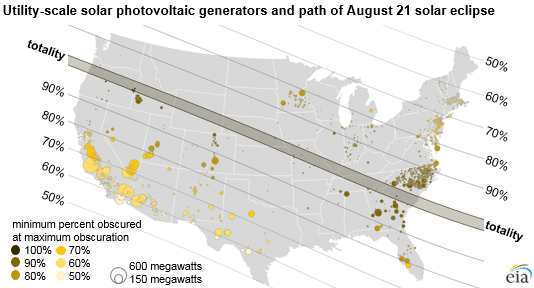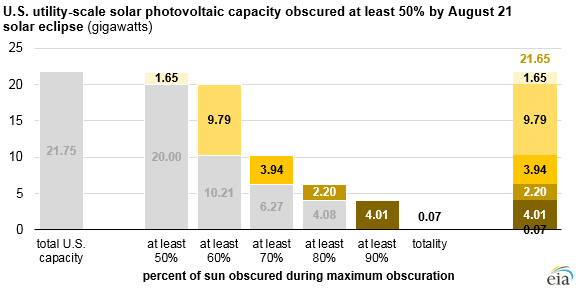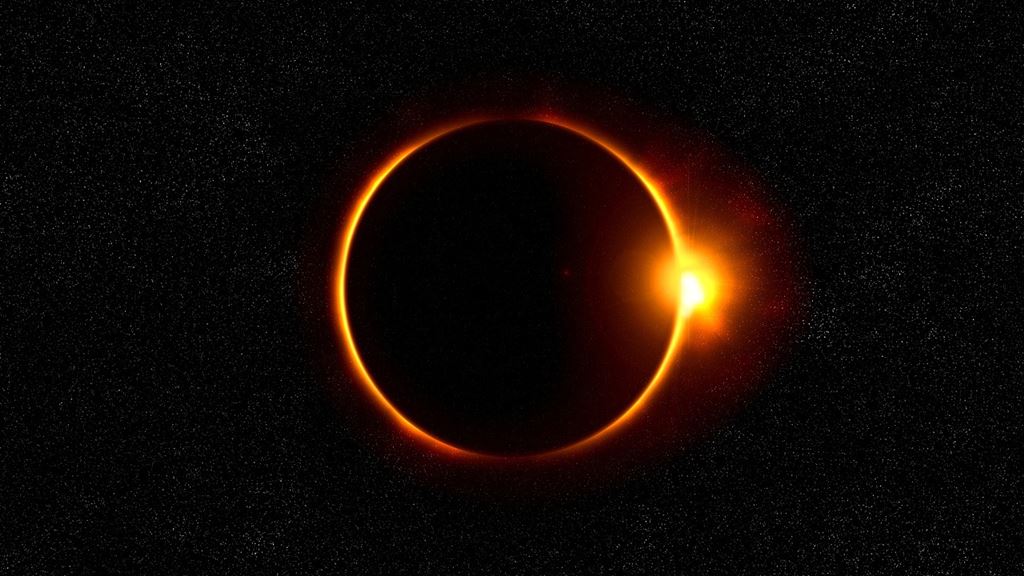The August 21 total solar eclipse which will be experienced from Oregon to South Carolina is already drawing substantial tourism and driving up lodging and airfare prices in cities on the path of the eclipse. However, the effect on the grid is expected to be significantly less dramatic.
 Yesterday the U.S. Department of Energy’s Energy Information Administration (EIA) released some data on the eclipse, showing that while sunlight in all 48 states of the continental United States will be at least 50% obscured, that only 70 MW of solar projects in Eastern Oregon are in the path of the full eclipse.
Yesterday the U.S. Department of Energy’s Energy Information Administration (EIA) released some data on the eclipse, showing that while sunlight in all 48 states of the continental United States will be at least 50% obscured, that only 70 MW of solar projects in Eastern Oregon are in the path of the full eclipse.
This is close to pure luck, given that the eclipse passes between a large volume of utility-scale solar in both North Carolina and Georgia, which have emerged as some of the top states for solar, and directly through relatively underdeveloped South Carolina.
 However, most of the utility-scale solar in North Carolina and Georgia will be 90% or more effected, and the fleets in the two states comprises most of the 4 GW of solar that will be most affected. Most of the utility-scale solar in California will only be 60-70% affected, given that the bulk of utility-scale solar is in Southern California, nearly 1,000 miles from the path of the eclipse.
However, most of the utility-scale solar in North Carolina and Georgia will be 90% or more effected, and the fleets in the two states comprises most of the 4 GW of solar that will be most affected. Most of the utility-scale solar in California will only be 60-70% affected, given that the bulk of utility-scale solar is in Southern California, nearly 1,000 miles from the path of the eclipse.
Despite this widespread impact on generation, technical experts in both California and the U.S. federal government that they expect that the eclipse will not affect reliability of the electric systems.
Solar PV and concentrating solar power represented only 1.4% of total U.S. electricity generation over the course of 2016, although this was significantly concentrated in certain states. In North Carolina and Georgia solar met only 3% and 0.8% of total electric demand in 2016.
However in California solar met over 10% of demand, and as such the greatest potential impacts are in California, despite the fact that the state’s solar is less directly in the path of the eclipse.
Despite this, in May California’s grid operator noted that it has sufficient fast-ramping resources to make up for a rapid fall in solar output and subsequent return once the eclipse passes. Additionally the North American Reliability Council has stated that it does not expect significant issues in the bulk power system nationwideO
This content is protected by copyright and may not be reused. If you want to cooperate with us and would like to reuse some of our content, please contact: editors@pv-magazine.com.









By submitting this form you agree to pv magazine using your data for the purposes of publishing your comment.
Your personal data will only be disclosed or otherwise transmitted to third parties for the purposes of spam filtering or if this is necessary for technical maintenance of the website. Any other transfer to third parties will not take place unless this is justified on the basis of applicable data protection regulations or if pv magazine is legally obliged to do so.
You may revoke this consent at any time with effect for the future, in which case your personal data will be deleted immediately. Otherwise, your data will be deleted if pv magazine has processed your request or the purpose of data storage is fulfilled.
Further information on data privacy can be found in our Data Protection Policy.